(Introduction – Ken Cooper was a well-known local historian who sadly passed away in December 2020. His family kindly donated all his archive material to Luton Heritage and a draft for a new book about Luton was found amongst the items. It was written by Ken back in 2001, but I believe it was never published. After getting agreement from his family, I have had the pleasure of transcribing it for publication on to the Luton Heritage website. This is the first of 7 chapters; the remaining six are also available on this site:-
- Chapter 1 – A Chronology
- Chapter 2 – Highways & Byways
- Chapter 3 – Men who saved the past
- Chapter 4 – The Utilities – The Luton Gas Works, The Railways, The Luton Water Company
- and the The Luton Electricity Company
- Chapter 5 – The Lodges of Luton
- Chapter 6 – Of Horses & Horsepower
- Chapter 7 – A look at two main streets of Luton Past
The book was dedicated to Ken’s wife Mary and the large number of photographers, known and unknown whose work appears there-in. – Greg Harrison – 2021)
FOREWORD
This book is intended for readers interested in the sights and background of Luton’s comparatively recent past and to refresh the thoughts and hazy memories of those wishing to remember the town as it was before the sweeping changes of the late twentieth century.
The definition of the word past is “a specific elapsed segment of time relevant to the present moment”. Thus “Luton Past” highlights some of the major points in its development from a virtual village to a bustling town with considerable impact on the country’s economy. Unfortunately, much of Luton’s history and historic past has been overlooked, forgotten and allowed to slip away unnoticed. Luckily, with the advent of the camera, events, street-scenes and architectural features were captured on glass plates and film enabling later generations to see a way of life completely alien to their own.
“The best way to suppose what may come is to remember what is past” – George Savile, 1st Marquis of Halifax, 1633-1695
Chapter 1. – A Chronology showing the salient events in two hundred years of Luton’s Past.
At the beginning of the nineteenth century Luton stood on the threshold of expansion and change beyond the wildest dreams of its 3000 inhabitants. Little did they realise that within two hundred years the population would have increased to almost 180,000 people and its village aspect change to that of an industrial town. The following items show benchmarks in Luton’s growth and history.
1800. Luton’s populace recorded at 3065 citizens. The Friend’s Meeting House was erected in Castle Street and is reputed to have been the first slate-roofed building in Luton. It stood in its own grounds which included an ornamental garden and small cemetery.
1809. A brick bridge was erected over the river Lea close to the junction of Lea Road, Windmill Road and Crawley Green Road. It replaced a ford and small planked footbridge. There were no houses in Lea Road at that time.
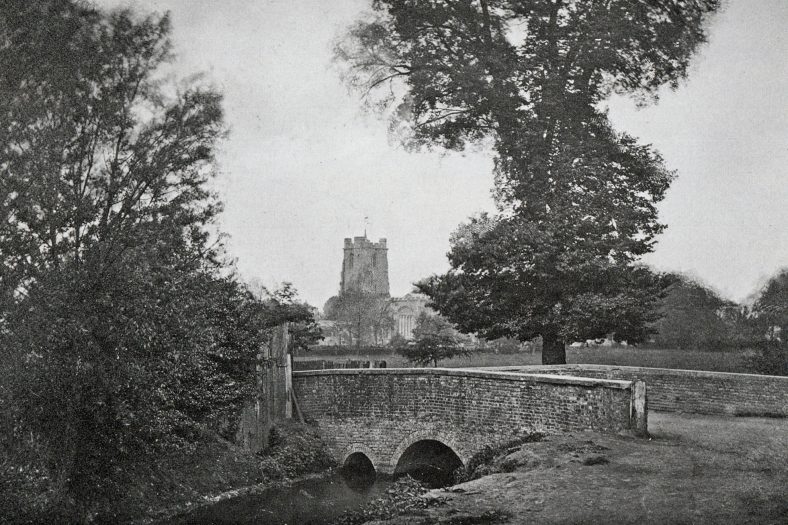
An early photograph by Frederick Thurston shows the first brick bridge carrying Crawley Green Road over the River Lea. Across the fields stands Luton’s Parish Church of St. Mary. Shortly after this picture was taken, this rural view was obscured by the newly-built terraced houses of Lea Road.
1814. The increase in the congregation at the Church Street Wesleyan Chapel led to the building of another and considerably larger chapel in Hog Lane, until then the traditional home of Luton’s annual pig market. As a consequence of this change, the ancient way was renamed Chapel Street.
1832. A new road called New Bedford Road was opened, linking Luton and Barton, replacing the old coach route. Stretches of the ancient roadway are still to be found as Old Bedford Road in Luton and as Coach Road in Barton.
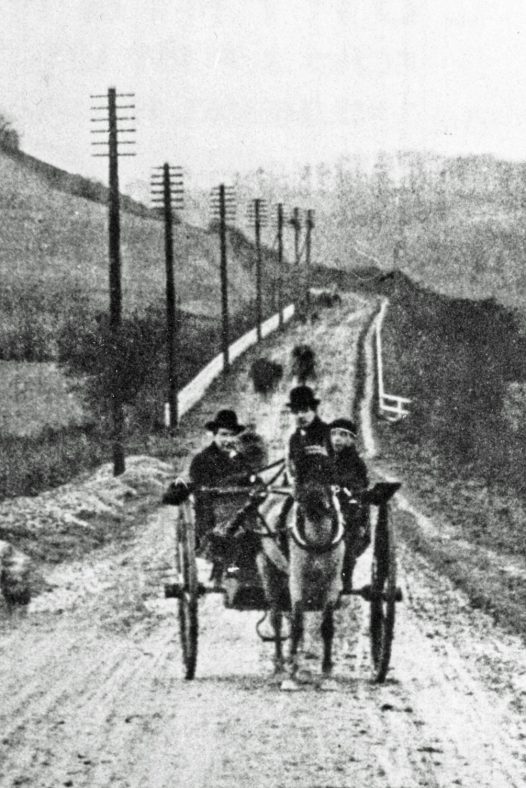
Taken in the late 1800s, a pony and trap is seen coming from Luton descending Barton cutting. Although rutted and slimy with chalk in the winter, it was far easier to negotiate than the old coach road that ran high on the hill to the left. Notice the telegraph poles carrying the telephone lines between Luton and Bedford.
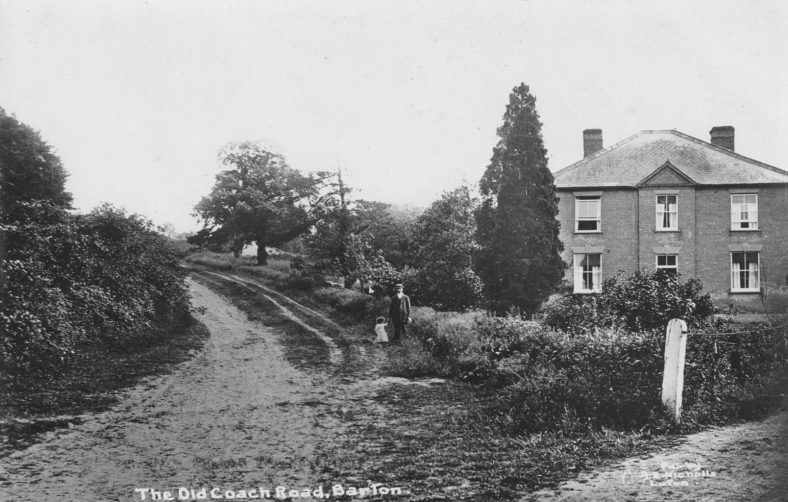
The Old Coach Road was used by horse-drawn coaches and goods wagons travelling between Luton and Barton before 1832 when the New Bedford Road was laid. The old road left Luton by crossing a ford over the River Lea known as the Horsepool, then traversing the lower slopes of Warden Hills and the ridge of Barton Hills, eventually entering Barton at the Barton-Hitchin Road. A scheduled passenger service between London and Ampthill used this route. The photograph, c.1915 shows the old disused road and nearby houses in Barton. They may still be seen today.
1834. Following meetings to finance and build a company to “light the town of Luton with gas”, a plant for producing coal gas was erected in Dunstable Lane, the old name for today’s Dunstable Road.
1837. The Union Chapel was erected in Castle Street as a result of the amalgamation of a group of Independent Baptists and the overspill of worshippers from Park Street Baptist Church.
1841. New housing developments were begun at the southern end of Luton for workers in the rapidly expanding hat industry, forming the districts of Park Town and New Town.
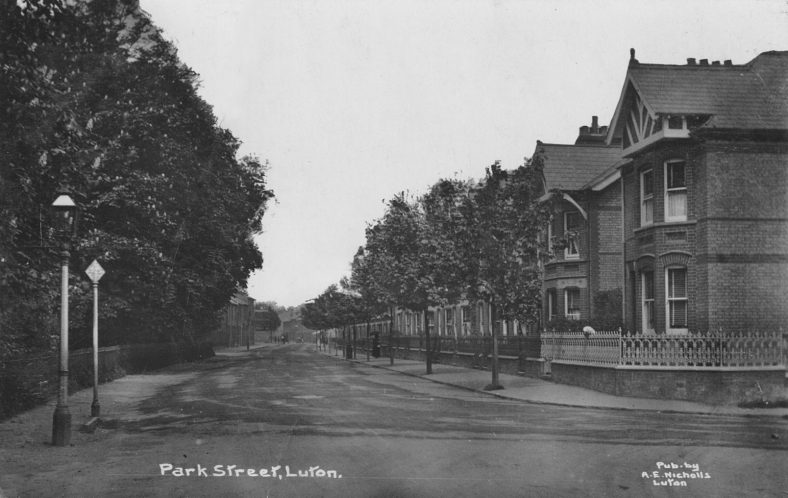
The area to the left of this picture of Park Street was originally known as Brache Farm and Brown Brick Field. Brown Brick was a corruption of Brown Bec, which got its name from a ditch or channel that carried excess rain and surface water from the farm fields. Much of the housing built here in the 1840s became the slums of the 1960s. The Luton Board of Health allowed better houses, planted trees and changed the name of the district to Park Town, to give a respectable and more countrified air to the area.
1847. Following meetings the previous year, a small town hall was built by a private initiative and registered as “The Luton Town Hall Company”. A strange paradox, a town hall not owned by the local government that used it! A situation that was remedied in 1874 when the Board of Health, the authority before the Borough Council, bought out the Town Hall Company.
1854. With the churchyard of St. Mary becoming full for burials, two new grounds for interment were opened; the Church Cemetery in Crawley Green Road, originally for church members and a General Cemetery in Rothesay Road.
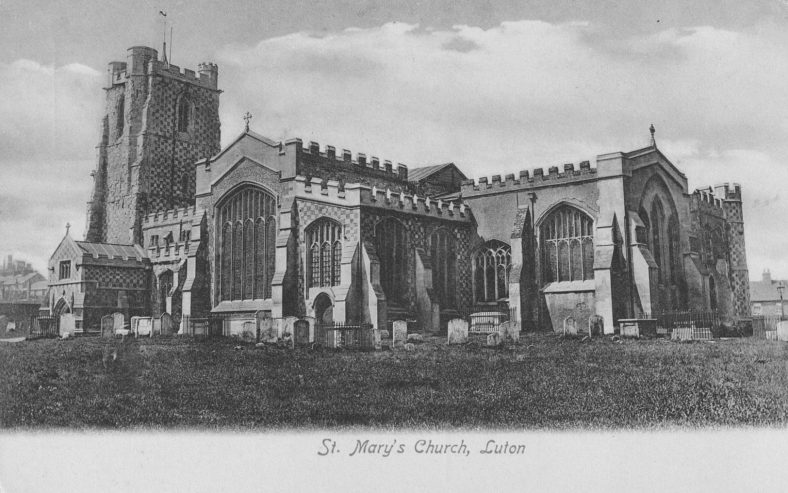
St. Mary’s Church and Churchyard, early 1900s. In times past also known as Luton Church or The Parish Church. Until the growth of the town caused the division of the old parish of Luton into two new parishes and the building of Christ Church in 1857, St. Mary’s was the only church holding Anglican services. Even today, almost 150 years later, among locals the church is still referred to as The Parish Church. The churchyard, which was closed in 1854, completely surrounded the church until a new hall and administration extension was added in 1969.
1855. First issue of The Luton Times, a weekly newspaper, was published by J. Wiseman from offices in George Street.
1857. Queen Square Schools opened. Although intended to cater for infants, girls and boys, the building was not large enough to hold the three separate schools and after overcrowding problems the girls school moved to a disused building in Church Street. Later, this school was used in the evenings and became known as The Adult School. ~ Christ Church, with a new parish, split from the original Luton parish and opened on 18th June.
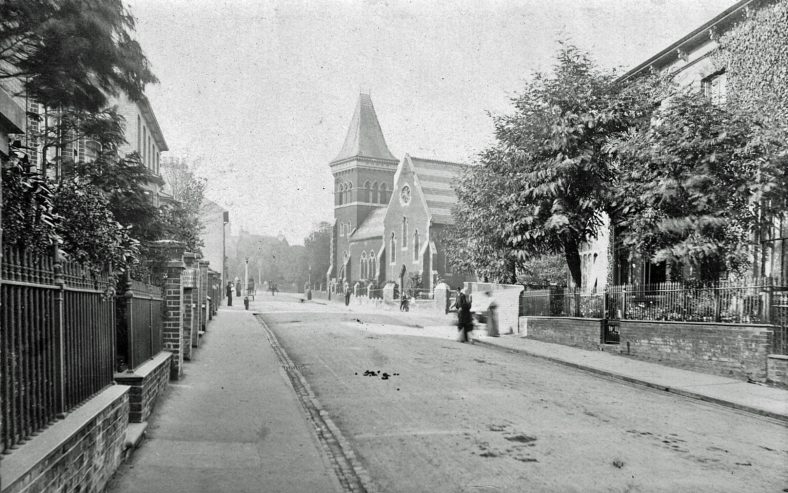
A view of Upper George Street looking towards Christ Church before the installation of the tramway system. Originally known as Dunstable Lane it was home to mainly professional families and lined with large well-kept houses and gardens. Many of these houses survived into the 1950’s when they were gradually replaced by blocks of commercial premises.
1858. The Luton-Dunstable section of what was to become known as The Hatfield, Luton and Dunstable Railway was opened. The fare for the journey to Dunstable was 3d (less than 1.5p) return. The station was at the head of Bute Street.
1860. The railway link between Hatfield and Luton was completed, making excursions to London possible via the Hatfield Main Line. The cheapest price was two shillings and sixpence (12.5p)
1865. On the 21st April, the first meeting of The Luton Water Company was held at The George Hotel.
1866. King Street Congregational Church completed, one of the outstanding landmarks of the town because of its 140ft steeple. The church had seating for 1,100 people.
1868. The foundation-stone of the Plait Halls was laid by Mr. P. Welch, a local hat manufacturer and philanthropist. It was hoped that buying and selling plait in pleasant working conditions would justify removing the old street market from George Street, where it had become a rowdy and disruptive activity. ~ Also in this year the Midland Railway Station, Station Road and pedestrian bridge to High Town were opened.
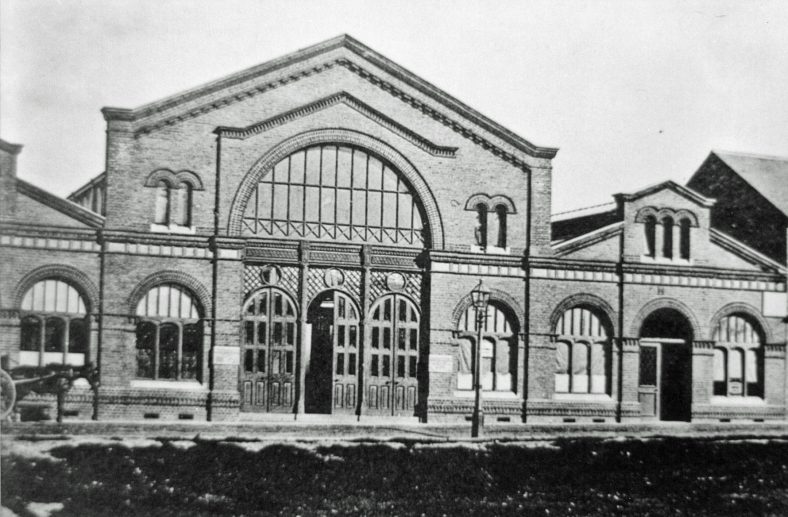
The Plait Halls, Cheapside. Intended as a cleaner, tidier venue for marketing Plait than the open-air street market in George Street, they were opened just as the decline in the manufacture of local plaits began to gather momentum. For a time foreign plait importers used the halls, but gradually their remit changed and they were used for holding exhibitions, social meetings, dinners and general entertainments. A more functional use was found in 1925 when the open-air market was transferred into them from Park Street.
1869. New Corn Exchange opened by Earl Cowper, K.G, Lord Lieutenant of Bedfordshire. The Court House in Stuart Street was also opened in this year.

The Corn Exchange, built in 1869 and demolished in 1951, stood at the southern end of George Street. It replaced an old public house called The Kings Arms and an ancient market building known as The Cornmarket House. This early photograph of the Exchange shows it just before the installation of the four-faced tower-clock.
1870. New Park Street Baptist Chapel opened.
1872. The Bute Hospital founded with a bequest of land from the Marquess of Bute. ~ In this year too, Luton’s first Public Baths were erected in Waller Street. Bathers with first class tickets could change in a cubicle whilst second class ticket holders had to undress sitting on a chair by the poolside!
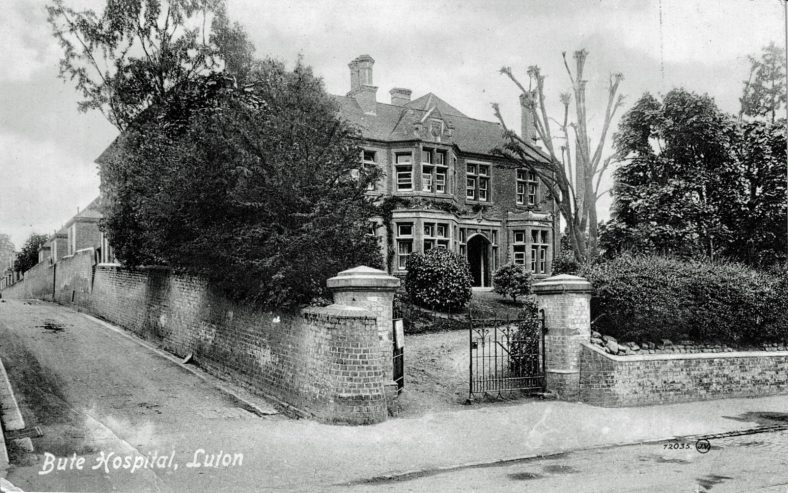
The Bute Hospital superseded the small, outdated Cottage Hospital that stood in High Town Road. “The Bute”, as it became known, was built in Dunstable Road and when officially opened in 1882 contained twenty beds.
1874. The Luton Town Hall Company Ltd. was bought out by the Board of Health prior to the Incorporation of the Borough.
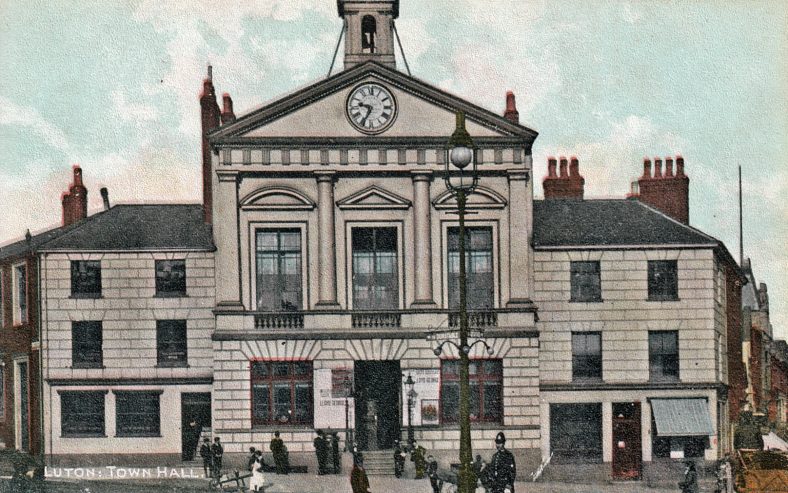
Luton Town Hall. Although the destruction of the Town Hall in the Peace Day riots of 1919 came as a shock to most Lutonians, steps had already been taken in 1887 to start acquiring properties bounded by Manchester Street, Gordon Street and Upper George Street “to provide the town with a site for a new, larger Town Hall”.
1876. Queen Victoria assented to the granting of a Royal Charter of Incorporation conferring the status of a Municipal Borough upon the town of Luton. This new status allowed Luton to select its own magistrates to run the court and hold democratic elections for seats on the Borough Council. At this time the College of Heralds approved Luton’s Coat of Arms, Crest and Motto, “Scientiae et labori detor”. From the members of the first council elected during this inaugural year, Mr. William Bigg, a local businessman, was chosen as the first Mayor of Luton.
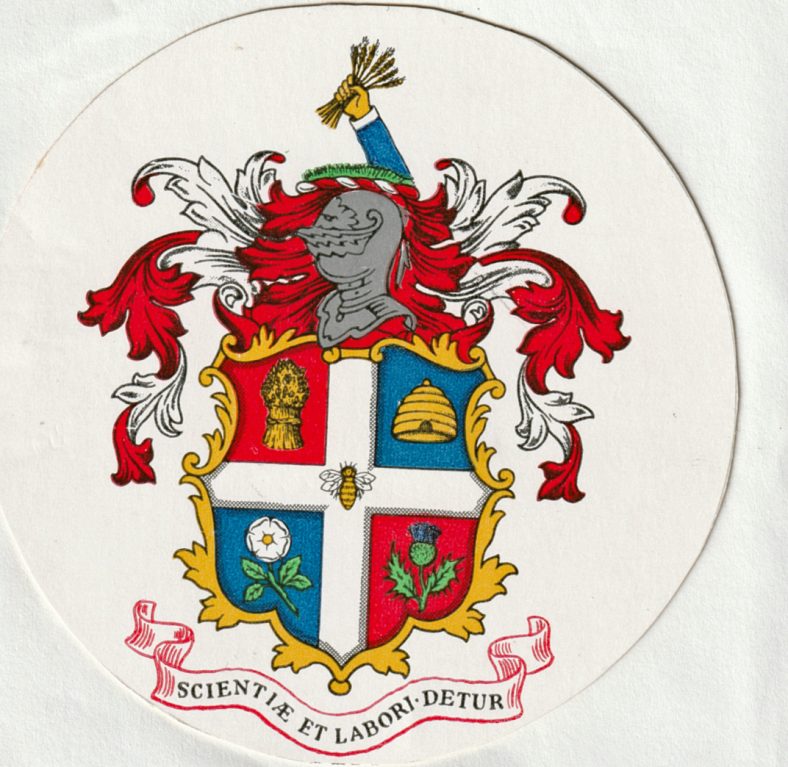
Luton Town Coat of Arms – “Knowledge and Hard Work”.
1881. Following heavy snowfalls in January, trains between Luton and Dunstable were prevented from running. The Railway Company blamed snow on the lines! ~ A new General Post Office built in Cheapside. A mock-Tudor building, the exterior showing fine examples of pargetting panels.
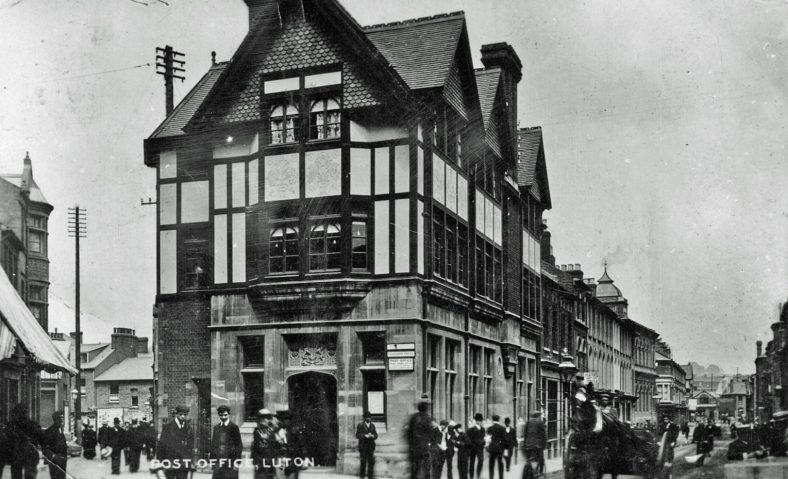
This photograph, taken in 1906, shows the pargetted mock-Tudor facade of the General Post Office in Cheapside. At this time there were over thirty-five pillar and wall boxes in the town, each of which was cleared nine times a day on weekdays, but only once on Sundays.
1884. At a Municipal Election held in Luton the Liberal candidates won all six seats being contested. The total number of votes cast numbered 5022. At this time the Borough of Luton had only three wards.
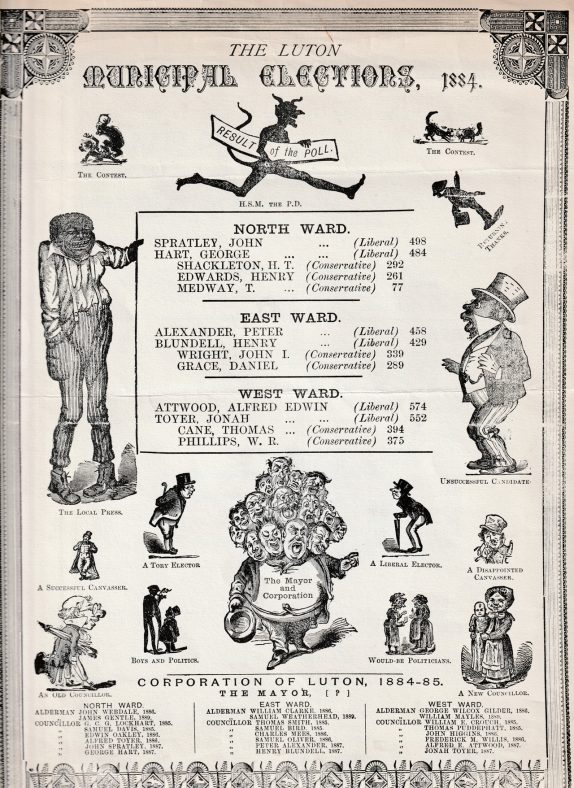
Result of the Poll sheet relating to the Luton Municipal Elections held in 1884. Printed and published by the editor of The Luton Reporter, this satirical look at a local election shows that the past had no time for political correctness!
1885. New Public Library in Williamson Street opened.
1886. In Castle Street a new Roman Catholic Church was opened. The building was steel-framed and clad in corrugated-iron sheeting. The Marquess of Bute subscribed £200 towards its construction. The first Mass was said on Christmas Day.
1887. A sewage system, which incorporated new sprinkler beds, pumping station and sewage farm, was opened at Kimpton Road.
1889. The first County Council Elections were held.
1891. St.Paul’s Church was dedicated but left incomplete since its intended spire was never added due to financial troubles.
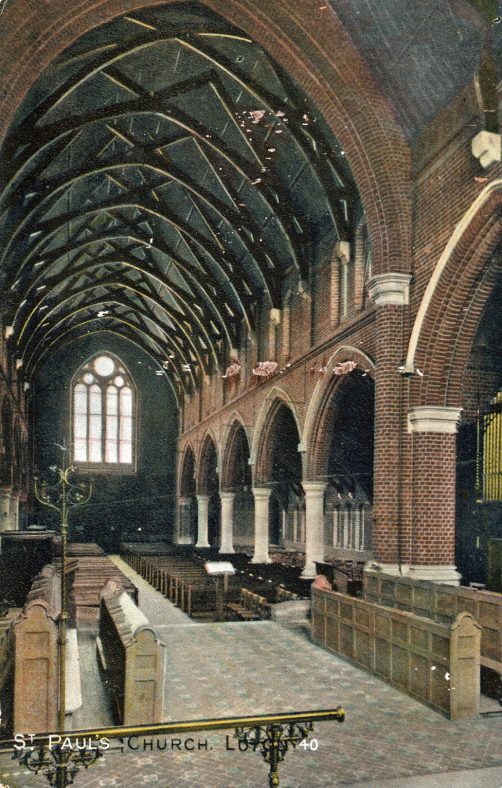
The roof of St. Paul’s Church became so badly damaged during the great storm of 1987 that it was too expensive to repair. Church of England officials decided that it would be more economic to demolish the old church and church hall, redeploy the sites and build a smaller, multi-purpose building incorporating a combined church and hall. The new St. Paul’s, which cost £500,000,stands in New Town Street and was consecrated by the Bishop of St. Albans in March,1991. The bell from the old church has been rehung on the new.
1894. The Luton Children’s Sick and Convalescent Home was opened by the Duchess of Bedford. Many years later it became known as the Children’s Annexe of the Luton and Dunstable Hospital, specialising in ear, nose and throat operations.
1898. The Grand Theatre was opened by the society beauty and actress Mrs. Lillie Langtry. She was born in the Channel Islands, and known to her audiences as the Jersey Lily. On the opening night her reciting of the inaugural address was followed by a performance of a religious play with a Roman background called “The Sign of the Cross.”
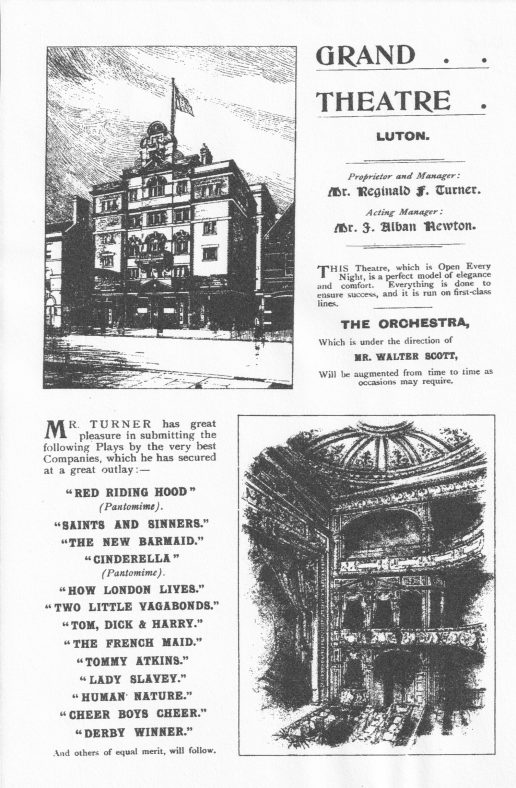
An advertising bill for The Grand Theatre known by its regulars “The Grand” or “The Gaffe”. The two illustrations give a good impression of both the interior which held an audience of 900, and the imposing exterior. When first built the theatre was not looked on favourably by members of Temperance Organisations because alcoholic drinks were served at the bar during intervals in performances.
1901. Following earlier proposals made by the Borough Council, the first phase of Luton’s Electricity Undertaking was completed the works being officially opened by Lord Kelvin, a Member of the Royal Society and a leading scientist of the day.
1902. The English and Scottish Co-operative Wholesale Societies, Cocoa and Chocolate Factory was opened in Dallow road.
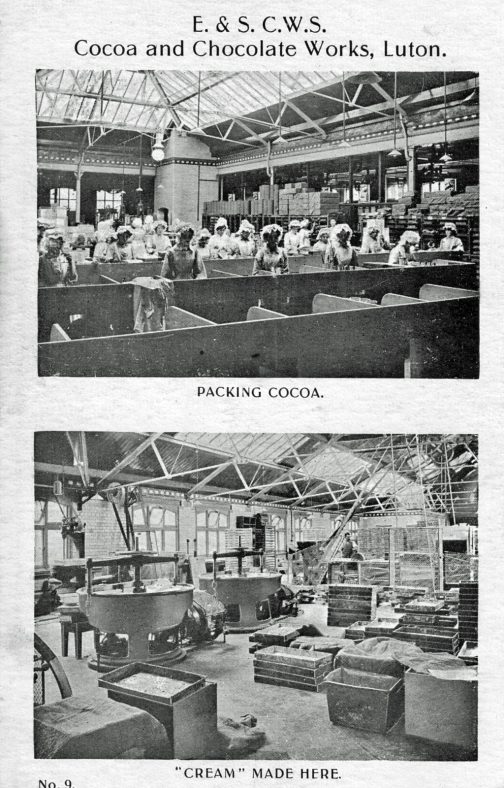
The Co-operative Wholesale Societies Cocoa and Chocolate Factory was built in 1902 as part of the “New Industries Initiative”. A wide range of mass-produced chocolate orientated confections including boxed chocolates, bars and Easter Eggs were manufactured at the factory under strictly controlled clean conditions. The popular “Lutona” Cocoa, another favourite line, was sold in grocery shops all over the country.
1903. Julius Wernher acquired Luton Hoo mansion and park for £250,000 and spent a similar sum on alterations and redecoration to make the building habitable and to house his art collection. ~ Following the building of houses on the Bury Park Estate, a new Congregational Church, a missionary church associated with King Street Church was built in Waldeck Road.
1905. Following a garden party for councilors and their wives, the mansion and gardens of the Wardown Park estate were opened to the public. The remaining portion which included the boating lake, ornamental walks through the park, bandstand, tennis and bowls facilities, was opened to the public the following Year. ~ Vauxhall Ironworks transferred from Wandsworth in London and amalgamated with West Hydraulic Engineering Company Ltd. in Kimpton Road. ~ A stag, running loose, was chased down Castle Street, captured in Windsor Street and released unharmed in woods near Berkhampstead. ~ A heron was shot on Leagrave Marsh.
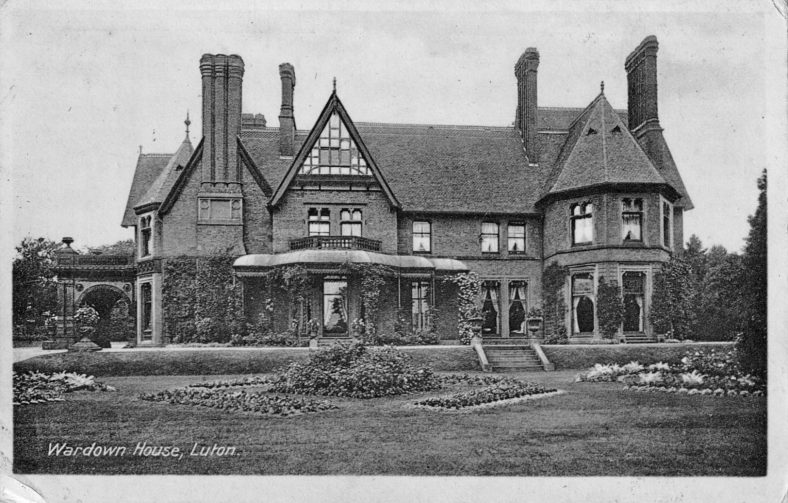
Wardown House, originally called Bramingham Shott, was built in 1877 as a family home for Frank C. Scargill, a local solicitor. The house and estate was purchased by Luton Borough council in 1905 and the grounds turned into a public park. During the Great War the house served as a military hospital and later, in 1931, its use was changed to that of Luton’s Museum.
1906. Commercial Cars Ltd. opened a new factory for the manufacture of motor cars in Biscot Road.
1907. Davis Gas Stove Company Ltd. transferred from Falkirk in Scotland to a new factory known as the Diamond Foundry on one of the sites earmarked for new industries in Dallow Road.
1908. Luton was slower than most provincial towns to organise and install a tramway system on its streets. Despite the unsuitable gradients and sharp corners of Luton’s narrow streets trams had to negotiate, in February, 1908, Luton Corporation Tramways started operating trams successfully on four routes in Luton. ~ George Kent Limited, a factory manufacturing venturi meters and measuring instruments was opened in Biscot Road. ~ The King Edward VIIth School opened on Park Square. Later to be known as The Modern School. ~ Death of Asher J. Hucklesby, four times Mayor of Luton. First manufacturer in Luton to mass produce hats.
1909. The first building specifically built to show films, The Anglo-American Electric Picture Palace, was opened in Gordon Street.
1910. A new Public Library costing £12000 to erect, a gift from Andrew Carnegie the Scottish philanthropist to the people of Luton, was completed. The opening ceremony, at which Whitelaw Reid the American Ambassador officiated was filmed and shown at a local cinema that night. As well as a lending library, the new building housed a children’s library, a large reference library, magazine and newspaper room and a lecture room that later doubled as a cinema. ~ The corrugated-iron Roman Catholic Church in Castle Street was replaced by a new brick church and presbytery. ~ Skefko Ball Bearing Co. Ltd. opened a new factory in Leagrave Road.
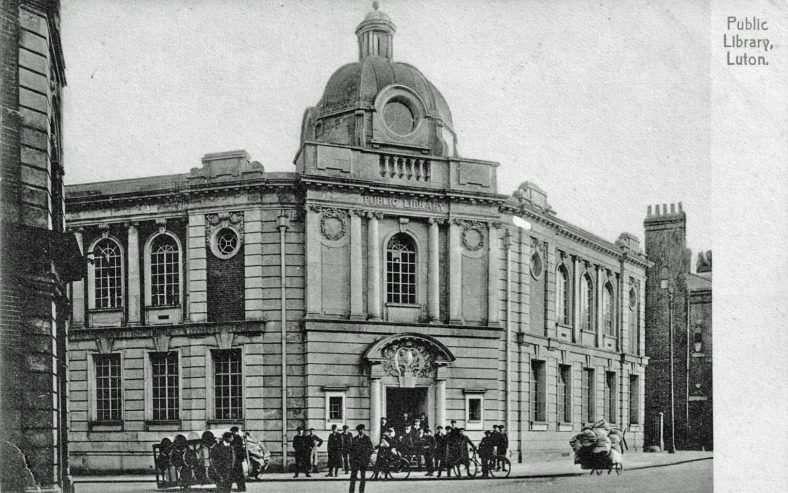
The Public Library replaced an earlier Free Library that stood on a similar site in Williamson Street. As you can see, the steps giving access to the Carnegie Library from George Street were one of the favourite trysting places in the town centre. Most citizens had great affection for this well proportioned civic building and mourned its demolition in the early 1960s.
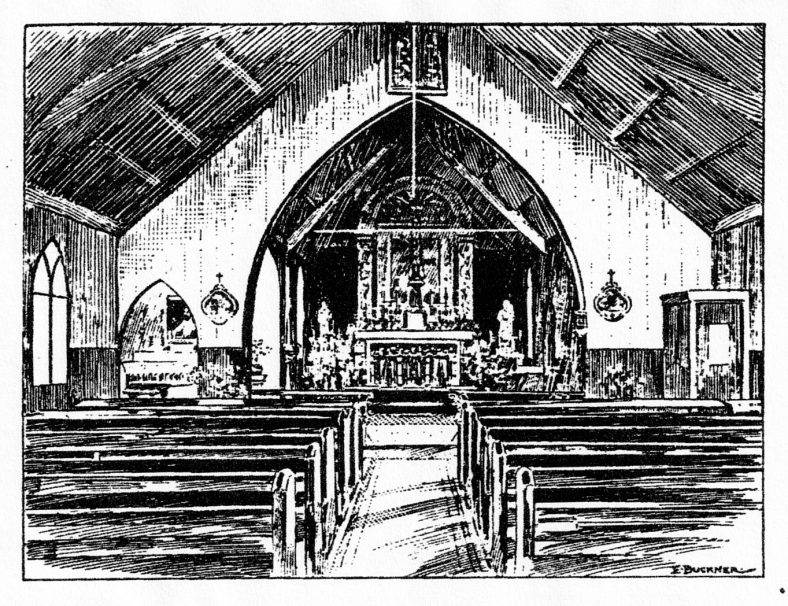
A contemporary line drawing that appeared in The Luton and District Year Book and Almanac for 1900, showing the interior of the first Roman Catholic Church. Being constructed of corrugated iron sheeting, imagine the effect on the acoustics during heavy rain.
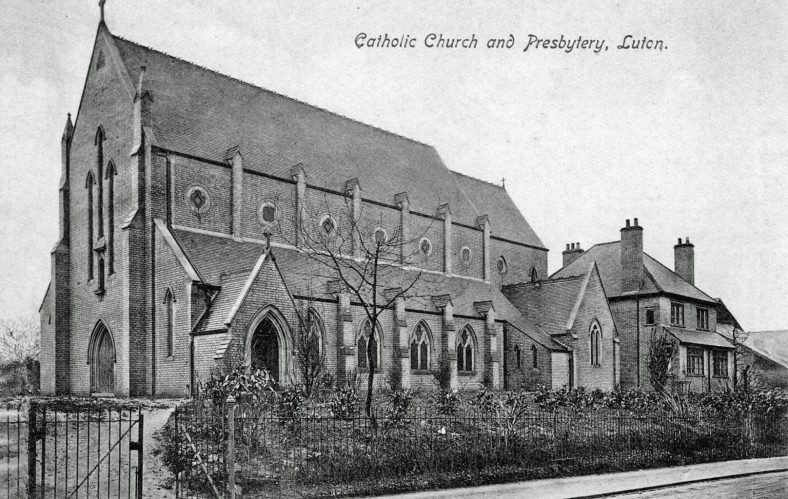
The Catholic Church of Our Lady Help of Christians, built in Castle Street to replace the original corrugated iron church.
1912. Sir Julius Wernher, owner of Luton Hoo and Lord of the Manor of Luton, died. He was buried in a mausoleum at East Hyde. It was reported that over five thousand people from Luton lined the route followed by the cortege. ~ The Palace Theatre in Mill Street opened, later renamed The Gaumont Cinema. Because the building was so close to the Midland Railway lines the Patrons continually complained about the noise from passing trains.
1914. Luton’s bid for County Borough Status failed due to opposition of the Bedfordshire County Council. ~ Francis Crawley, JP, owner of Stockwood Park and House died. He gave the site upon which All Saints Church was built. ~ Grand Review and Tattoo Recruiting Drive held at Luton Hoo. From the start of the Great War in August1914 until 11th November 1918, when the Armistice was signed, almost thirteen hundred Luton men and women had given their lives.
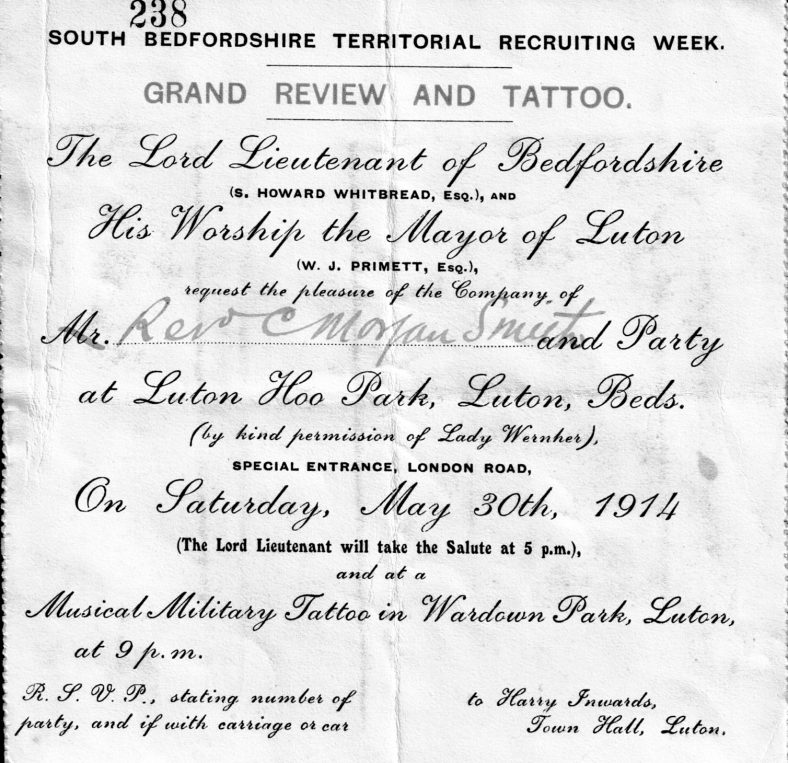
Only days before this ticket was due to be used, Viscount Edward Grey said, “The lamps are going out all over Europe”. Military Recruiting Tattoos were held in many towns to encourage the growth of the British Army as a prelude to the outbreak of the First world War.
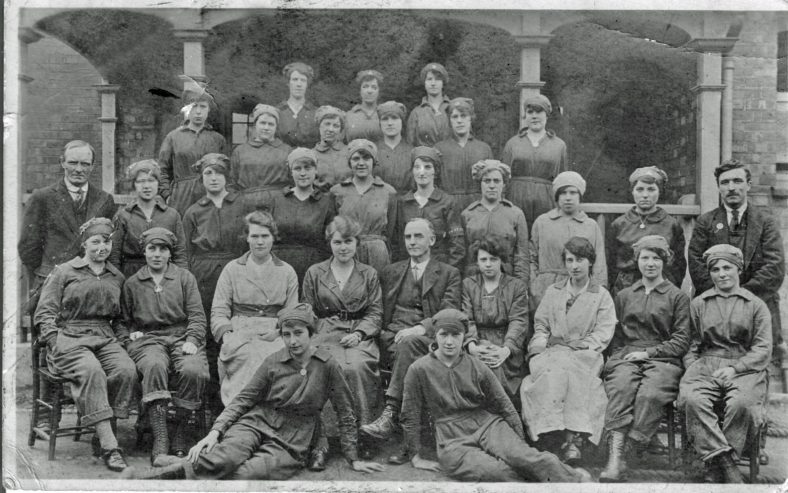
During the Great War when much of the town’s manpower was serving in the armed forces, women were employed in local factories on “war work”. The photograph shows munition assemblers at Kent’s Chaul End Lane factory where they were engaged in the manufacture of shells, fuses and detonators
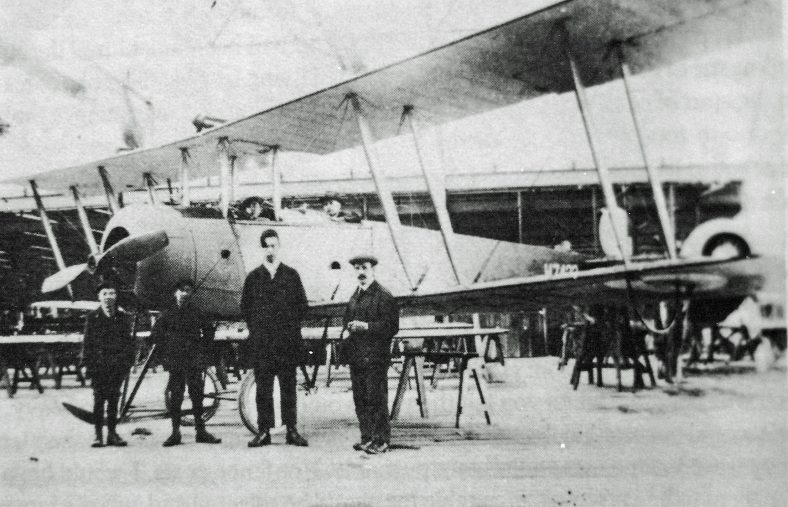
Putting the finishing touches to a First World War training aeroplane in the doping and final finishing hangar at Hewlett and Blondeau’s, Omnia Works, in Oakley Road, Leagrave.
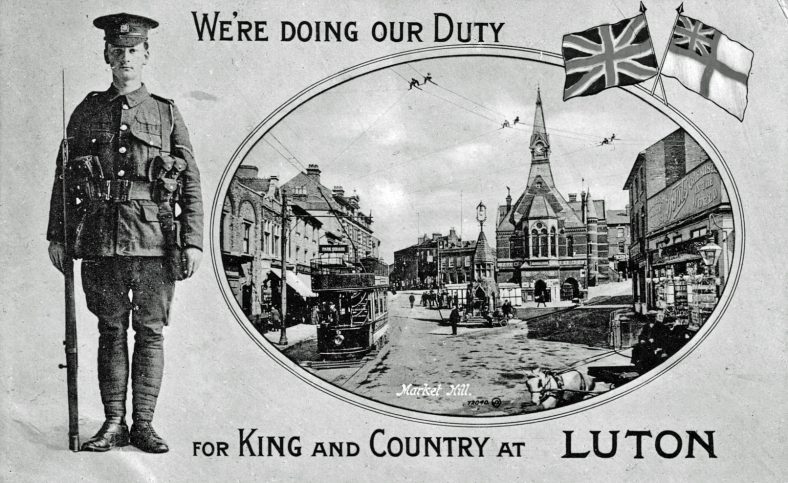
A wartime morale-boosting post card with a patriotic message. They were usually sold in the mess or camp writing room, written and sent home to families who soon found out what their sons, husbands or sweethearts thought of the weather under canvas; the sergeant; canteen food and lack of correspondence from home!
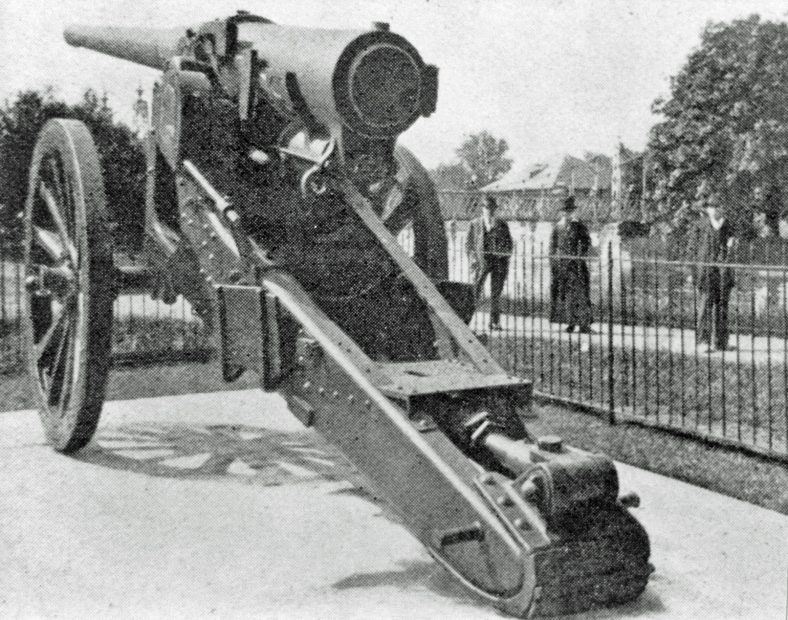
This heavy artillery piece was captured by the Fifth Bedford Regiment during an action at Gaza in the Palestine campaign. After the war it was mounted, as a trophy, on a plinth in Wardown Park. The old gun was taken away for scrap when metals became short in the second World War.
1919. 28th June, Peace Proclaimed. Official end of Great War. ~ On the evening of 19th July, the day designated by the King to be a national day of celebration to mark the end of the war, rioting broke out in the centre of Luton during which the Town Hall was gutted by fire.
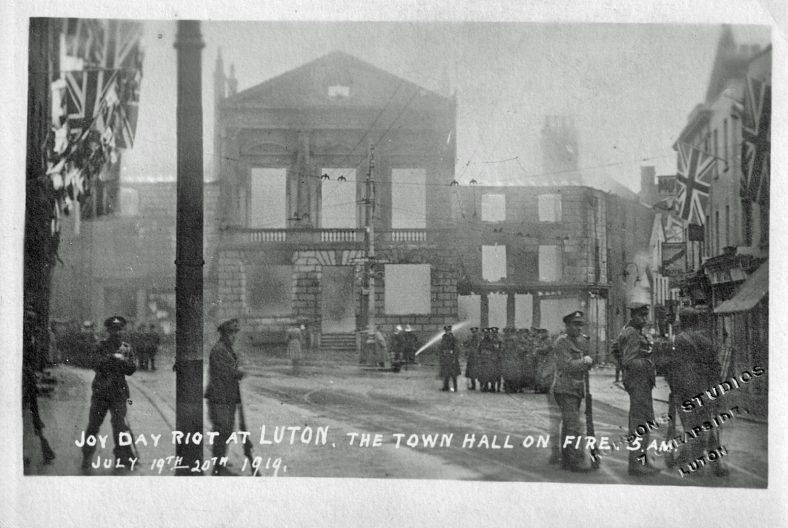
The morning after the night before! Firemen still damping down the smoking ruins of Luton Town Hall following the results of the disastrous Peace-day celebrations. The armed military presence was to curb further vandalism in the town centre.
1920. A temporary church made of huts from Biscot Camp was opened and dedicated to St Andrew.
1922. In front of a subdued crowd in George Street Lady Ludlow unveiled the Luton War Memorial. She then went on to open the Luton Hoo Memorial Park which was her gift to the people of Luton in memory of her son Alex, who was killed in action in France, 1916.
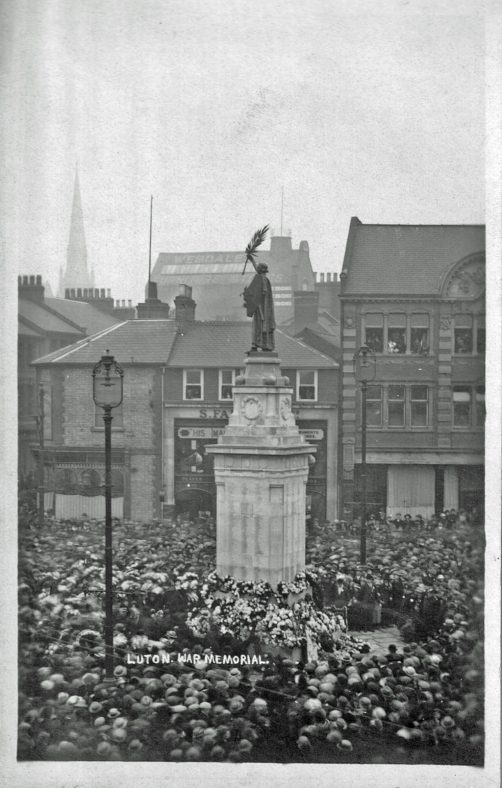
The sadness of the people of Luton. The War Memorial, erected in George Street, was paid for by public subscription, designed by Sir Reginald Blomfield, R.A. and topped with a female figure bearing a shield and holding a palm branch, by Sir Hamo Thornycroft, R.A.
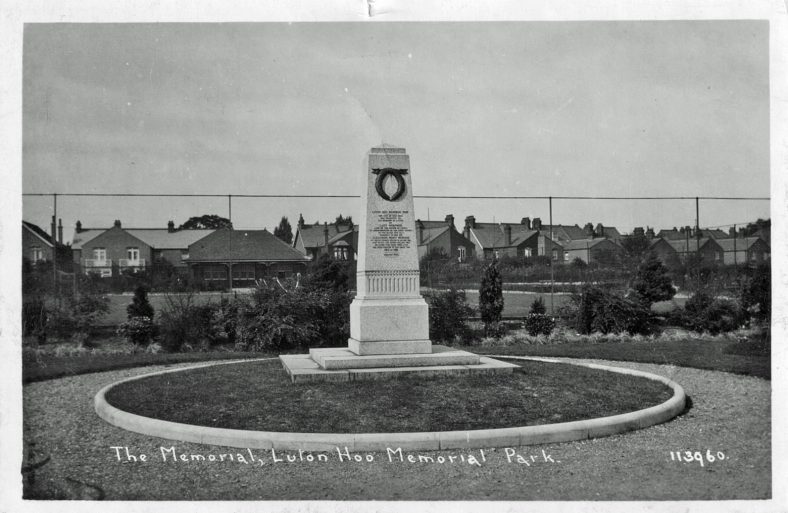
The sadness of a mother. The memorial, “In Commemoration of the Great Victory of the Allies and as a memorial to her son Alexander Pigott Wernher and to all the other gallant men of Luton who gave their lives for their country in the Great War”, together with the Luton Hoo Memorial Park given to the Borough of Luton by Lady Wernher.
1923. A new General Post Office and Telephone Exchange was built in Upper George Street. The new buildings replaced the outgrown mock-Tudor Post Office that stood in Cheapside. There was a major expansion in the provision of telephone lines with a capacity of four thousand subscriber connections.
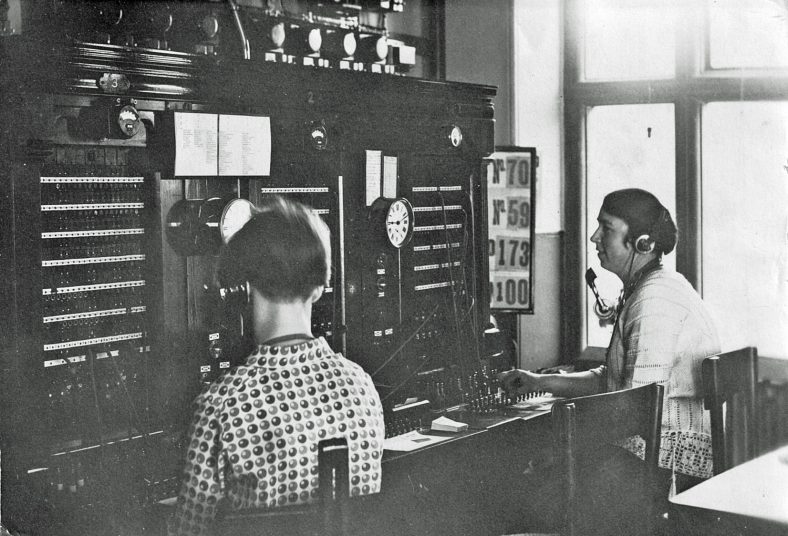
Interior view of the New Telephone Exchange showing operators sitting at their switchboards, ready to “plug in and make a connection” between two subscribers’ telephones. A successful connection would be marked by the operators intoning “You’re through”.
1925. Vauxhall Motors Limited taken over by American car manufacturer General Motors.
1926. The Omnia Works, one-time home of the Hewlett and Blondeau aeroplane factory was acquired by Electrolux Ltd. ~ General Strike. Luton News prints national newspapers.
1928. Leagrave and Limbury become part of Luton.
1930. Beeswax being heated on a gas ring was responsible for causing Luton’s worst hat-factory disaster when flames swept through Vyse’s factory in Bute Street. Eight workers were killed in the conflagration.
1931. Luton Museum transferred from Carnegie Library to Wardown House.
1932. Trams left the streets of Luton and were replaced by the maroon and cream painted buses of Luton Corporation Transport.
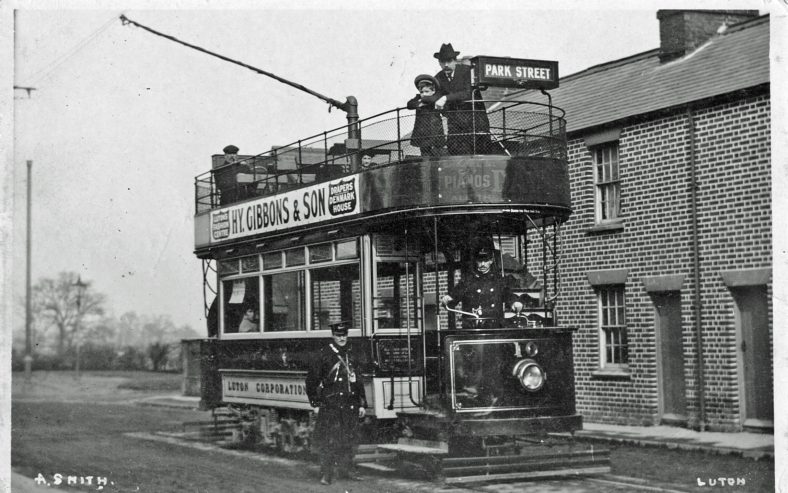
Car Number 10 stands at the Round Green terminus ready for the descent via High Town to George Street. The green and cream painted monsters travelled the Luton tram-lines for nearly a quarter of a century. In 1931/32,the last year they ran, the trams carried 2,932,912 passengers, travelled 277,076 miles and yet, after expenses, showed a profit of only £29-11s-8d.
1933. Stopsley loses its village status and becomes part of Luton.
1934. Road traffic control in the town centre saw the introduction of One Way Streets in Bridge Street, South Road and Williamson Street and Traffic Lights at the junction of Mill Street, New Bedford Road and Crawley Road followed by those at Dunstable Road, Cardiff Road and Upper George Street.
1935. In July, a new open-air swimming pool was opened by Alderman G. Wistow-Walker, Chairman of the Council’s Baths Committee. Although a welcome addition to the town’s bathing facilities it did nothing to help competition swimmers who were campaigning for year-round swimming, since both indoor and outdoor pools were closed during the winter months. ~ Work started on the new Town Hall. ~ A new Recreation Ground was opened at Kingsway.
1936. The new Town Hall was officially opened by the Duke of Kent on October 28th,1936. There was a certain smug amusement in the town when, stirring the memories of the Peace Riots in 1919, it became known that fireproof materials had been specified for the erection of the new building!
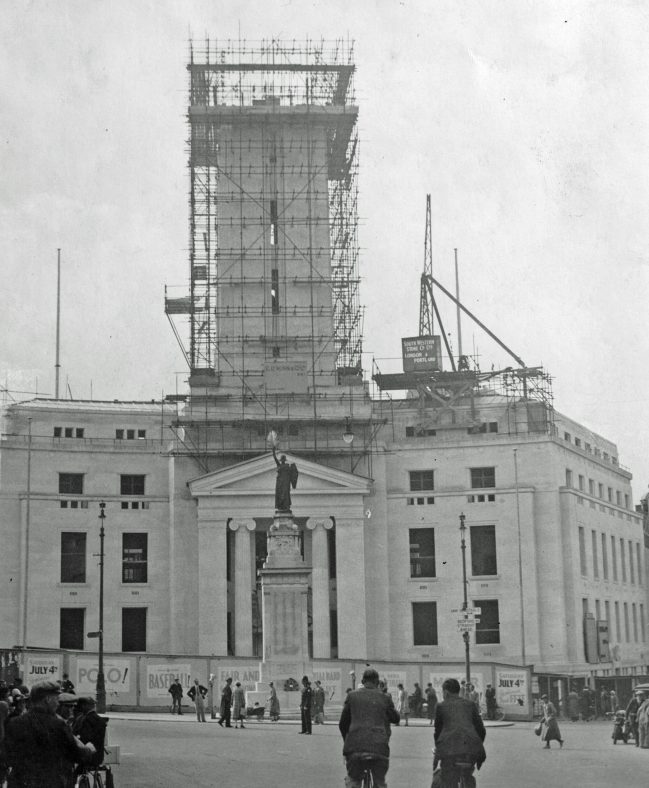
Phoenix-like the new Town Hall rises from the ashes of the old. Clad in scaffolding the bell tower awaits completion and the addition of clock and chimes. The clock was paid for by a bequest from the will of Alderman Albert Wilkinson, a former Mayor of Luton.
1938. Sir Kingsley-Wood, Secretary of State for Air, opened Luton Municipal Aerodrome at an air display to mark the occasion. The display was memorable because of the appearance of the piggy-back flying-boat and seaplane, Maia and Mercury.
1939. The Luton and Dunstable Hospital was opened by Queen Mary accompanied by Lady Ludlow. They drove from Luton Hoo through bitterly cold streets lined with cheering schoolchildren. ~ Luton experienced its first Air Raid Warning at 8am on 6th, September, four days after the start of the second World war. Luckily it was a false alarm!
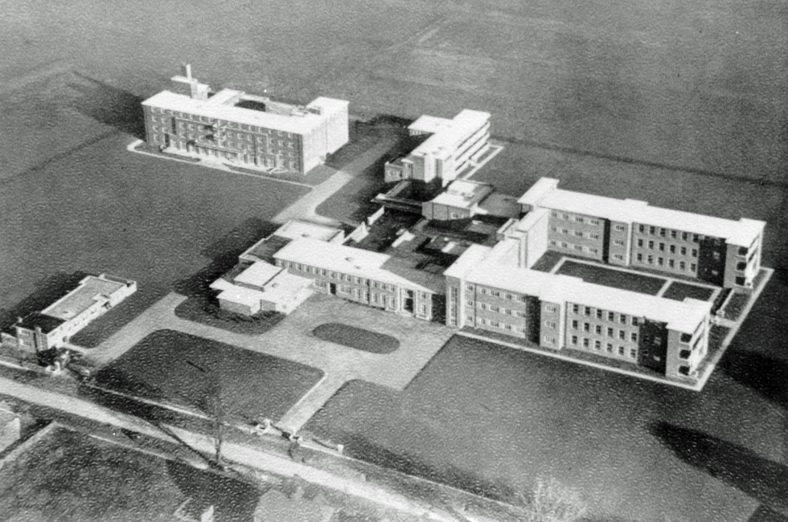
Barely recognisable from today’s vast development, this aerial photograph shows that when first built the Luton and Dunstable Hospital stood in virtual isolation on a greenfield site. On 14th, February, 1939, the opening day, there were still open fields separating the towns of Luton and Dunstable. Innovations at the new hospital included six open-air verandahs looking out onto the Dunstable Road. Lewsey Road can be seen in the bottom left-hand corner.
1940. Luton suffered its first and worst air raid, on Friday 30th August, when 194 bombs were dropped on the South of the town, killing 59 and injuring 140 people.
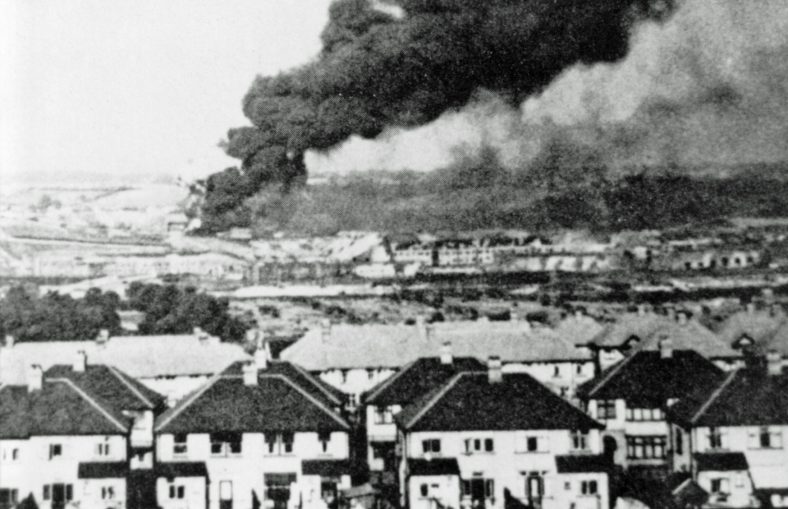
Smoke and flames billow skywards as Vauxhall Motors is hit in Luton’s first air attack. This view looking across the Lea Valley was taken from the West Hill Water Tower within minutes of the raid taking place. (Photograph courtesy of The Luton News).
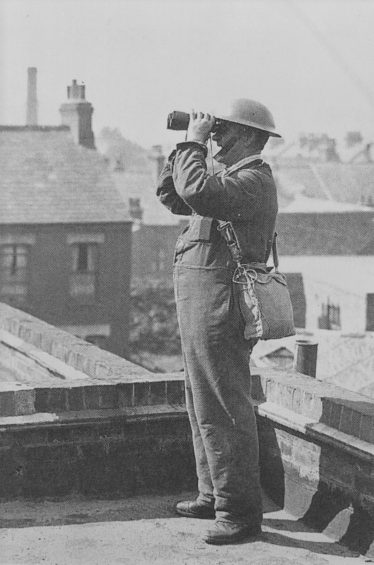
To prevent loss of production time when an air raid warning was sounded, many factories employed “spotters” to search the skies for enemy aircraft so that employees were only warned to take shelter when danger was imminent. In this case warning was given by loudspeaker in the factory and visually in the surrounding district by raising a drum up a pole.
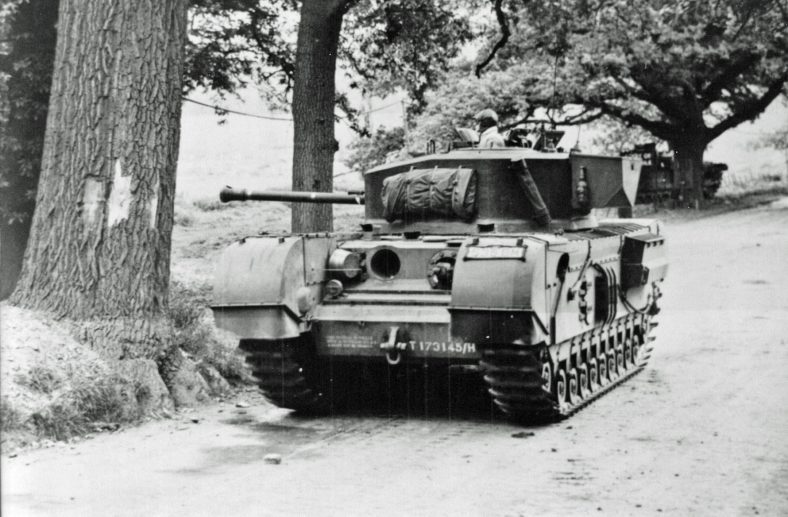
In the desperate atmosphere following the Dunkirk evacuation, Vauxhall Motors Ltd. were asked to design and manufacture a new tank. The Company had already designed and run a new engine suitable for tanks, taking them 89 days to complete. The engine was incorporated in the new tank, called the Churchill, which was in production within a year. The picture shows a Churchill at the test site in the grounds of Luton Hoo.
1942. New Automated Sewage Disposal Plant opened at East Hyde.
1944. Lady Ella Keens becomes Luton’s first woman Mayor.
1945. End of the second World War, celebrations held in George Street. ~ William Warby became Luton’s first Labour Member of Parliament and Mr.Jack Roberts, Luton’s first Labour Mayor. ~ Stockwood House and estate purchased by Luton Borough Council, breaking the Crawley family’s long association with the town.
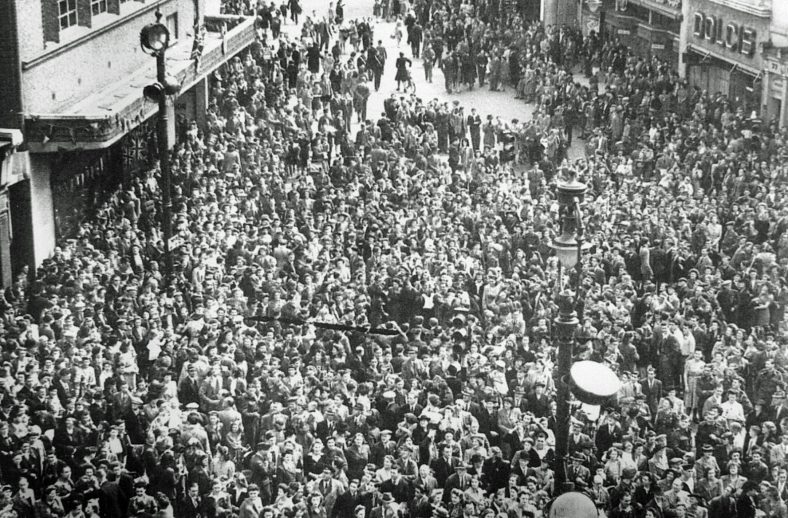
Although rumours about the end of the war in Europe had been rife for several days, when the official news was released “that it is all over” on 7th May,1945, the spontaneous release of emotions swept through Luton like a tide, centring upon George Street outside the Town Hall. There was a communal expression of thanksgiving, relief and happiness, tempered with the realisation that the war in the East had yet to be won.
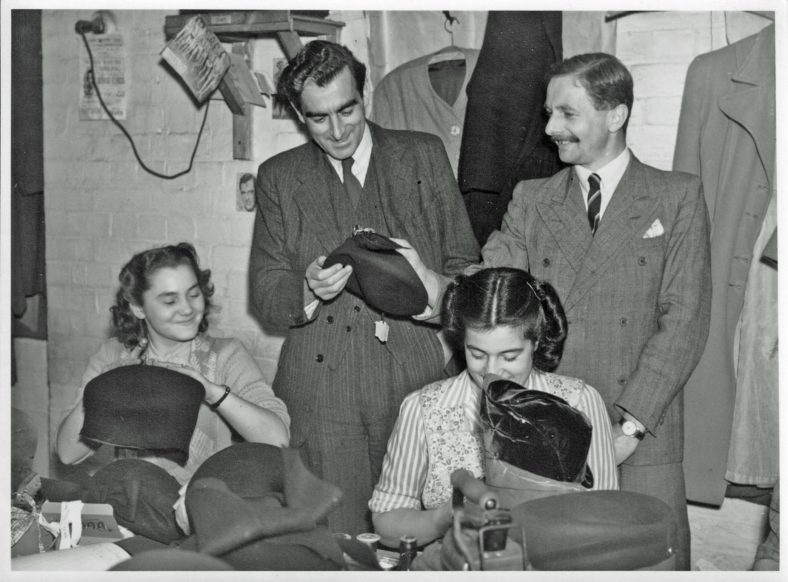
Mr. William Warbey, Luton’s Labour Candidate in the first post-war General Election, familiarises himself with working conditions in local industries. He is seen here watching milliners at work in a Luton hat factory.
1948. 1st January, British railway companies nationalised, with the L.N.E.R. and L.M.S. Railways becoming British Rail, Eastern Region. ~ 1st, April, The Luton Electricity Undertaking nationalised, coming under the control of the British Electricity Authority.
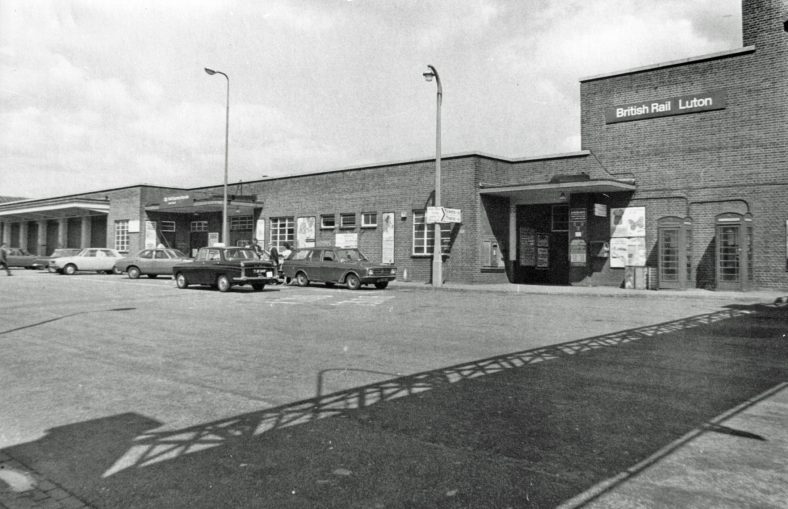
With Nationalisation came the new logo “British Rail”, seen here on the elevation of the main line station in Station Road. Note the shadow of the passenger bridge that spans the railway, linking the Town Centre with High Town.
1950. Dr Charles Hill, nationally known as the Radio Doctor, elected as United Liberal and Conservative MP for Luton.
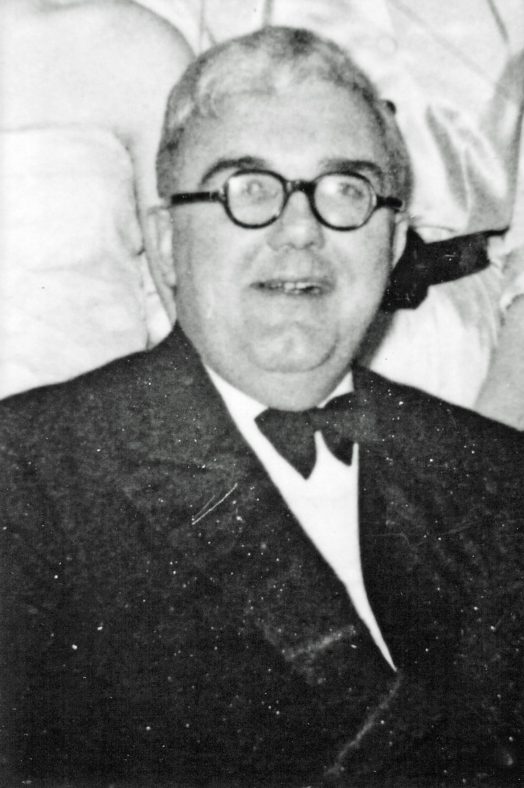
Charles Hill, one of Luton’s longest sitting and popular Members of Parliament, achieved success in a remarkably varied career. On becoming known nationally as the Radio Doctor, he took to politics where he served as Parliamentary Secretary to the Ministry of Food, Postmaster General, Minister of Housing and Local Government, and the Chancellor of the Duchy of Lancaster. He was sacked by Harold Macmillan in 1962 and the following year was created a life peer and asked to chair the Independent Television Authority. Five years later, Harold Wilson invited Lord Hill, as he then was, to become chairman of the B.B.C, a position he held for five years. Lord Hill was also chairman of Laporte Industries and the Abbey National Building Society. He was given the Freedom of the Borough of Luton in 1978 and died on August 22,1989.
1951. The upper part of the Corn Exchange demolished, leaving the basement public toilets remaining.
1954. Stockwood House still occupied by The Alexandra Hospital for Children, a legacy of the war. Limited use of the estate was made available to the people of Luton, the house was demolished in 1964 and a Municipal Golf Course added in 1973.
1956. The Fire Brigade Headquarters in Park Street closed and rehoused in a new Fire Station at Studley Road.
1957. New Post Office opened in Dunstable Road. It was car friendly being equipped with a drive-by post box and stamp machines.
1959. Mr. Ernest Marples M.P. ,the Minister of Transport, opened theLuton section of the Ml motorway. ~ Last sale held at Luton Cattle Market through lack of business. The closure marked the end of an almost thousand year old country market.
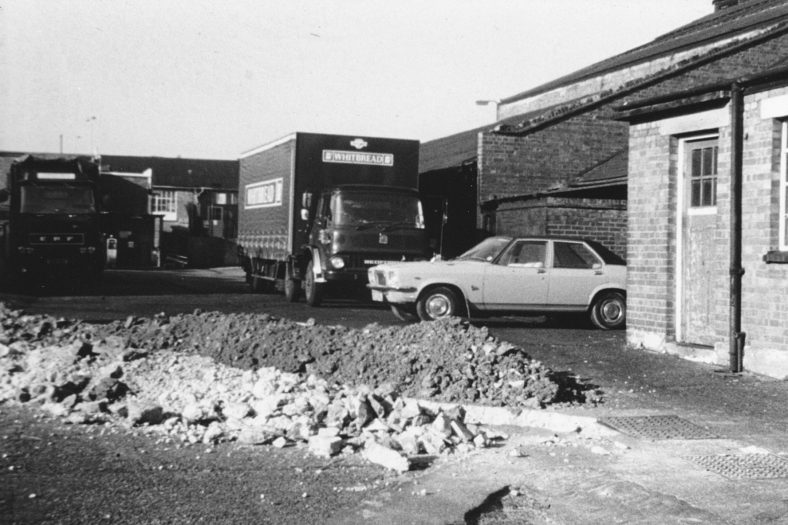
Known as Cumberland’s Yard, it was here, just off Park Street, that the Luton Cattle and General Auction Market was held on Monday mornings between 1937 and 1959, after moving from the previous site in Bridge Street. The door on the right led to the “cashing up” room and auctioneer’s office.
1960. The Technical College was superseded by the College of Technology, the forerunner of Luton University.
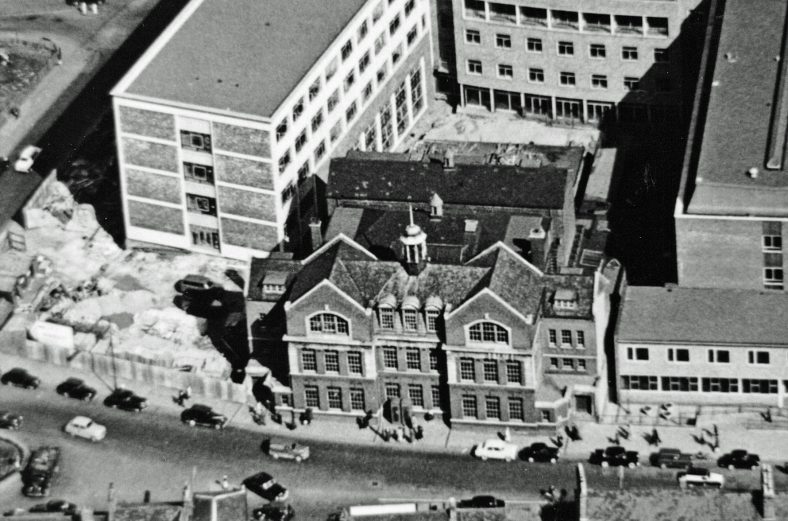
An aerial view of Park Street and Church Street shows the newly built College of Technology almost ready for occupation while the old Technical College stands ready for demolition.
1962. H.M. Queen Elizabeth and H.R.H. The Duke of Edinburgh visited the town to see the newly opened Luton Central Library.
1963. Dr Charles Hill, MP elevated to the peerage became Lord Hill of Luton, later becoming Chairman of the B.B.C.
1964. Luton became a County Borough and took control of the police force, education and parts of planning, highways and welfare services previously controlled by Bedford. Trees were planted in Wardown Park to mark the occasion.
1965. New indoor Swimming Pool opened in Bath Road.
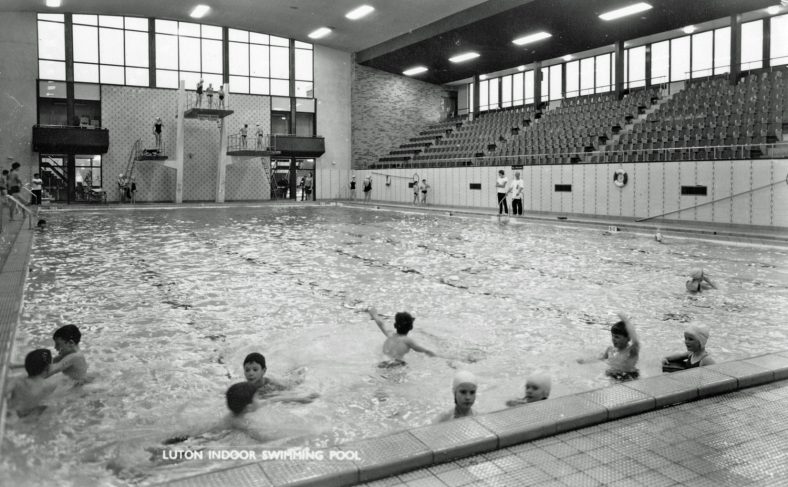
Built adjacent to the open-air pool in the appropriately named Bath Road, when officially opened, the new swimming pool provided the facility of all-year-round swimming for Luton’s bathers and swimmers. Something that had been campaigned for by club swimmers for almost fifty years.
1969. New Whitbread brewery opened at Leagrave.
1970. The end of an era. Mass demolition of shops and houses in Luton town centre leading to the erection of the Arndale centre.
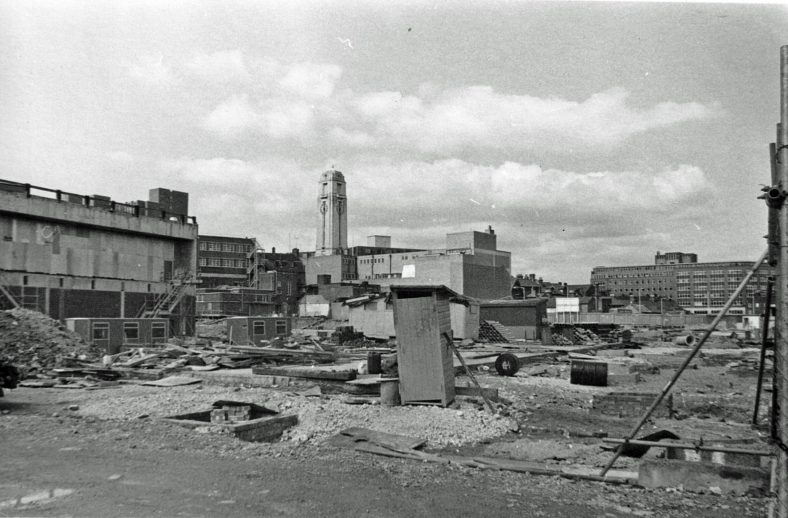
A view looking through Luton Town Centre toward the Town Hall Clock Tower, on the site of Waller Street. Every building in this street was demolished, except the Masonic Hall, to make way for the erection of the Arndale Centre. The Building on the right skyline is Cresta House, in Alma Street.
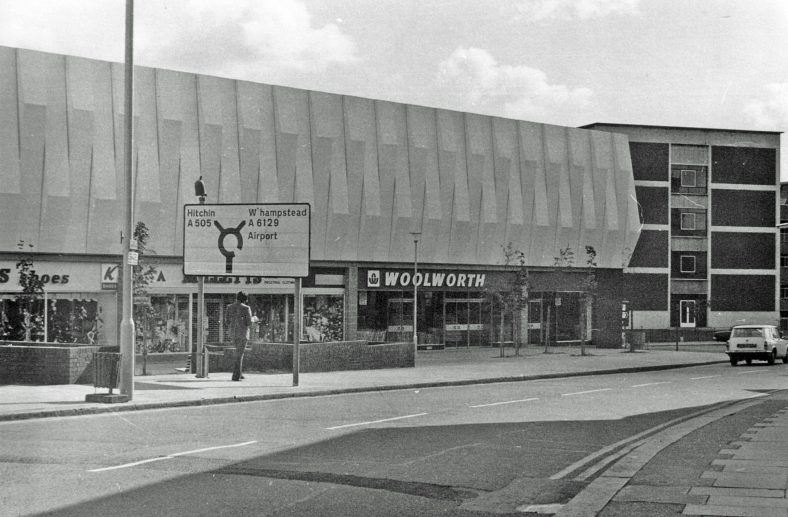
As the Arndale Centre began to take shape, new and re-located familiar shops jostled for position in what was the largest shopping centre in Europe. Loved or hated, the building of the Arndale concept changed the face of Luton for ever.







Comments about this page
Some wonderful photographs and insights into the past 200 years of Luton’s history. Many thanks to Ken Cooper’s family for giving permission for these papers to be published.
What a wonderful collection of some memories in the towns history. Great to look back at what was Luton. Thanks to the family of the late Ken Cooper for having the vision to realise that many people would gain much pleasure on viewing these time machine photos and writings of the past thank you so much.
Add a comment about this page